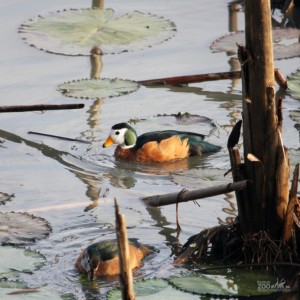 The African Pygmy Goose is a perching duck from the sub-Saharan Africa area. They are the smallest of Africa’s wildfowl, and one of the smallest in the world. The average weight of a male is about 10 oz. (285 grams) and for the female about 9 oz. (260 grams). Their wingspan is between 5.6 inches to 6.5 inches (142 millimeters to 165 millimeters). The African pygmy goose has a short bill which extends up the forehead so they resemble geese. The males have a white face with black eye patches. The iridescent black crown extends down the back of the neck. The upper half of the fore neck is white whereas the base of the neck and breast are light chestnut colored. The sixteen tail feathers are black. The wing feathers are black with metallic green iridescence on the coverts. The belly is white. The bill is yellow with a black tip and the feet are dark-gray to black. The female has a gray face with a dark brown eye stripe and smudged brown patches on the cheeks and nape. She has a dark-brown forehead, crown and back of neck with a slight iridescence. The breast and flanks have a dark chestnut coloration. The back is dark brown and the wing feathers are dark brown-black. The belly is white. The bill is yellow, the upper part mottled brown with a dark brown tip and the feet are also dark-gray to black.
The African Pygmy Goose is a perching duck from the sub-Saharan Africa area. They are the smallest of Africa’s wildfowl, and one of the smallest in the world. The average weight of a male is about 10 oz. (285 grams) and for the female about 9 oz. (260 grams). Their wingspan is between 5.6 inches to 6.5 inches (142 millimeters to 165 millimeters). The African pygmy goose has a short bill which extends up the forehead so they resemble geese. The males have a white face with black eye patches. The iridescent black crown extends down the back of the neck. The upper half of the fore neck is white whereas the base of the neck and breast are light chestnut colored. The sixteen tail feathers are black. The wing feathers are black with metallic green iridescence on the coverts. The belly is white. The bill is yellow with a black tip and the feet are dark-gray to black. The female has a gray face with a dark brown eye stripe and smudged brown patches on the cheeks and nape. She has a dark-brown forehead, crown and back of neck with a slight iridescence. The breast and flanks have a dark chestnut coloration. The back is dark brown and the wing feathers are dark brown-black. The belly is white. The bill is yellow, the upper part mottled brown with a dark brown tip and the feet are also dark-gray to black.
Location: African Elephant Crossing - Seasonal
Share:
Range
The African pygmy goose is found in sub-Saharan Africa and Madagascar. They are known to be nomadic.
Habitat
They live in slow flowing or stagnant water with a cover of water lilies. This includes inland wetlands, open swamps, river pools, and estuaries.
Conservation Status
Least Concern
Primary Threats
Gestation
The female lays 6 to 12 eggs that are incubated for 23 to 26 days.
Litter
There is usually between 6 and 12 young with each mating.
Behavior
They live in strong pair bonds that can last over several seasons and their breeding is triggered by rains.
Reproduction
The African pygmy goose will nest in natural hollows or disused holes of barbets and woodpeckers in trees standing in or close to the water. They have strong pair bonds that may last over several breeding cycles. The move to mate is triggered by the rains which increases the food supply to the parents and young.
Wild Diet
The African pygmy goose eats predominantly the seeds of water lilies, seeds, and vegetative parts of aquatic plants. They also may eat aquatic insects and small fish.
Zoo Diet

